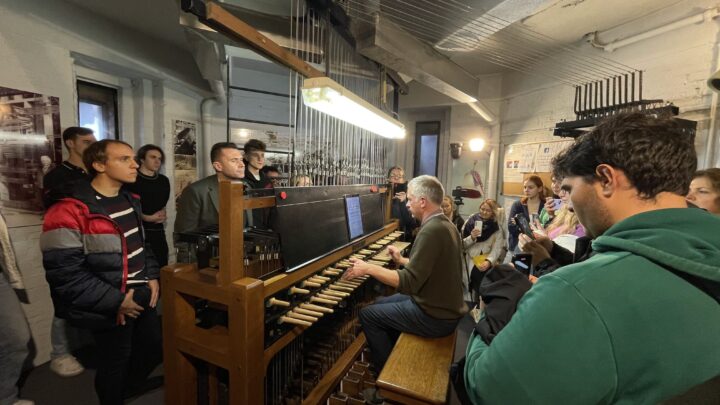Celebrating crossovers, collaboration, creativity, and carillon: Highlights from the Blended Intensive Programme Week at Thomas More University of Applied Sciences
The Blended Intensive Programme (BIP), hosted from November 4 to 8 by Thomas More University of Applied Sciences (Mechelen, Belgium), brought together 32 motivated international students and 10 supporting lecturers and researchers from seven institutions. With the central theme of safeguarding and enhancing the accessibility of Mechelen’s carillon culture—home to the Royal Carillon School and the impressive Saint Rumbold’s Tower—the week-long immersive event exemplified the Living Heritage Journeys initiative’s mission to connect intangible cultural heritage (ICH) with sustainable and inclusive tourism practices.

© Dávid Vasali
A week of collaboration, innovation, hard work… and Belgian culinary delights
The BIP experience featured a rich blend of theoretical sessions on intangible cultural heritage and tourism, fieldwork, and collaborative project development, rooted in the Design Thinking methodology. The central challenge was “How might we make carillon culture in Mechelen more accessible and experiential to a broader audience while ensuring safeguarding the practice, valorisation, and sustainability?”. This challenge guided the week’s activities, which included:
- Online presentations: Experts shared insights on living heritage and its interaction with tourism, the carillon’s historical and cultural significance, and innovative strategies for tourism development.
- Visits and fieldwork: Participants explored iconic locations like the Royal Carillon School "Jef Denyn", the Saint Rumbold’s Tower (complete with a climb up its daunting 538 stairs), and Leuven’s university library carillon. Sensory experiences like the Heavy Metal Route podcast and a personalised playlist performed by carillonneur Luc Rombouts added depth to the cultural immersion.
- Group work: Students collaborated in eight teams, focusing on themes such as inclusivity, safeguarding, marketing, and community involvement. They applied design thinking principles to create personas, stakeholder maps, and innovative prototypes addressing the challenges of integrating living heritage with tourism.
- Prototyping and presentations: The week concluded with group presentations evaluated by a panel of experts in tourism, living heritage, carillon culture, and experience design. Each team showcased creative, sustainable solutions that tried to balance the needs of practitioners, stakeholders, and tourists.
Beyond the academic rigor, the week celebrated joy, discovery, and cultural connections. Fueling the participants’ efforts were Belgium’s famed fries and waffles, providing much-needed energy during intense brainstorming sessions.
BIP’s origins and collaborative spirit
The BIP was the result of a close collaboration between Thomas More University’s International Tourism and Leisure (ITL) Bachelor programme and the Tourism Research team. Together, they combined academic expertise, innovative methodologies, and a shared passion for cultural heritage and tourism.
Supported by the Living Heritage Journeys-project, the BIP embraced its mission of bridging living heritage with sustainable tourism practices while offering international students a deep dive into the diverse world of living heritage. Contributions from partner institutions—Haaga-Helia University of Applied Sciences (Finland), the Estonian Entrepreneurship University of Applied Sciences, InHolland University of Applied Sciences (Netherlands), Universidade Portucalense Infante D. Henrique (Portugal), Kaunas University of Applied Sciences (Lithuania), and Budapest Business University (Hungary)—enriched the programme. Local stakeholders, including the Mechelen tourism board, members of the carillon community, and Workshop intangible heritage, added valuable insights and real world perspectives.

© Marco Scholtz
Reflections on the week
The Blended Intensive Programme (BIP) was more than an academic event: it was an immersive journey into the interplay of cultural heritage, tourism, and collaboration. As the week unfolded, it became clear that the true value of the programme lay in the experiences and connections it fostered, both within and beyond the formal sessions. For many students, the programme seemed to be an eye-opener, offering a hands-on opportunity to engage with an intangible cultural heritage practice in a way that many had never experienced before. The meticulous attention to understanding the carillon culture, from its historical roots to its contemporary significance, provided students with a deeper appreciation of the challenges and opportunities associated with safeguarding heritage. The collaborative group work was equally impactful. For many, working with peers from diverse cultural and educational backgrounds was both challenging and enriching. Differences in perspective often led to creative solutions that might not have emerged otherwise. As organisers, witnessing the programme come to life was deeply rewarding. Seeing students grapple with real world challenges, apply theoretical knowledge, and transform their understanding of heritage into actionable ideas underscored the importance of such initiatives.
A particular highlight was observing the shift in students’ perceptions of living heritage. Initially, many approached the carillon as a niche or abstract concept. By the end of the week, they spoke with enthusiasm about its potential to connect communities, enhance tourism, and foster cultural pride. Local stakeholders, including members of the carillon community and the Mechelen tourism board, expressed their optimism for the innovative ideas students brought forward. The BIP highlighted the intricate relationship between heritage and tourism. The programme emphasised that safeguarding living heritage is not merely about preserving the past but also about ensuring its relevance in the present and future. The week reinforced that while challenges exist, the opportunities for collaboration, innovation, and meaningful engagement far outweigh them. By involving stakeholders at every step, from community members to policymakers, sustainable and inclusive strategies for heritage and tourism can emerge. As we move forward, the BIP serves as a reminder that heritage is something to safeguard—it is something to share, celebrate, and cherish. And while we’ll all remember the aching legs from countless stairs, we’ll also cherish the ringing tones of the carillon and the spirit of connection that echoed throughout the week.